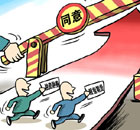Society
Wind-solar generators fuel life of herdsmen
(Xinhua)
Updated: 2010-02-16 19:10
 |
Large Medium Small |
HOHHOT: On the steppes of north China's Inner Mongolia Autonomous Region, herdsman Cao Zhenglong sits and enjoys the Spring Festival TV gala on a LCD screen. He doesn't worry about the electricity he is using, assured in the knowledge his electricity generator can turn both wind and solar energy into electricity.
"With the new wind-solar generator installed last year, we expect to buy more home appliances and live a more modern life," Cao's wife Yue Cuiyun said.
Cao's cottage is 20 km from the nearest power transformer station on the Erdos Grassland. His home generator is his only source of electricity.
| ||||
The small, three-blade turbine that he once used produced only tiny volumes of electricity. He could barely keep a lamplight on at night without a strong wind.
The couple said that the regional government began to encourage herdsmen and farmers to buy the wind-solar home generators last year by providing subsidies. The subsidy reduced the severity of many rural households' electricity shortage.
Under the policy, herdsmen only pay 3,500 yuan (US$512) for a 8,500 yuan wind-solar generator. The government subsidy covers the rest.
Cao said the government subsidy is helping herdsmen and farmers upgrade their home generators.
With an area of 1.18 million square kilometers, Inner Mongolia makes up 12 percent of China's territory and is the third largest of China's 31 mainland provinces, autonomous regions and municipalities. The region's vast rural areas are scarcely populated, and home wind-power generators have become popular there.
The lack of stable household electricity supplies in the region has negatively impacted on the quality of life of herdsmen.
Cao said before 2009, his only modern household appliance was a black and white TV.











